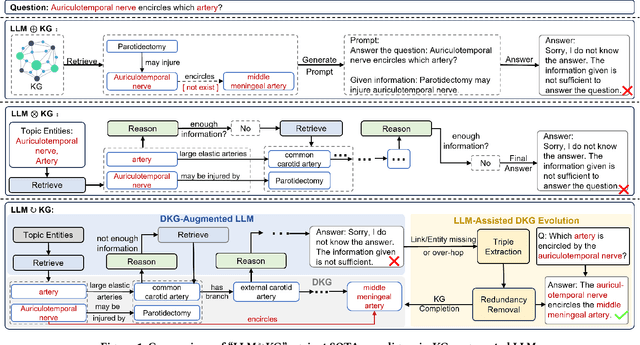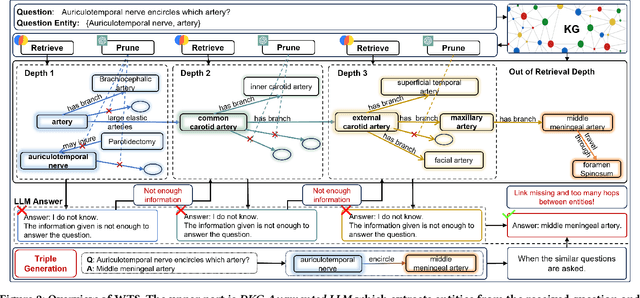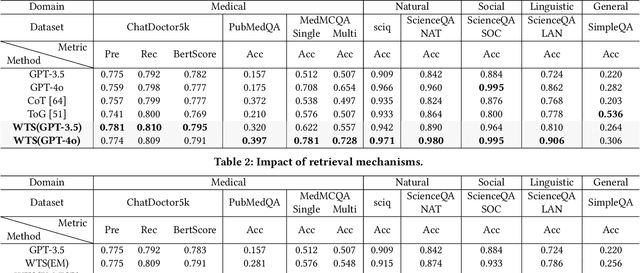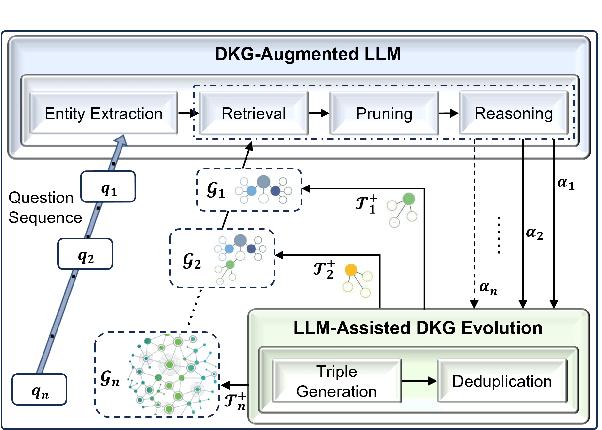Yang Bai
HyperMAN: Hypergraph-enhanced Meta-learning Adaptive Network for Next POI Recommendation
Mar 27, 2025Abstract:Next Point-of-Interest (POI) recommendation aims to predict users' next locations by leveraging historical check-in sequences. Although existing methods have shown promising results, they often struggle to capture complex high-order relationships and effectively adapt to diverse user behaviors, particularly when addressing the cold-start issue. To address these challenges, we propose Hypergraph-enhanced Meta-learning Adaptive Network (HyperMAN), a novel framework that integrates heterogeneous hypergraph modeling with a difficulty-aware meta-learning mechanism for next POI recommendation. Specifically, three types of heterogeneous hyperedges are designed to capture high-order relationships: user visit behaviors at specific times (Temporal behavioral hyperedge), spatial correlations among POIs (spatial functional hyperedge), and user long-term preferences (user preference hyperedge). Furthermore, a diversity-aware meta-learning mechanism is introduced to dynamically adjust learning strategies, considering users behavioral diversity. Extensive experiments on real-world datasets demonstrate that HyperMAN achieves superior performance, effectively addressing cold start challenges and significantly enhancing recommendation accuracy.
Benchmarking Multimodal RAG through a Chart-based Document Question-Answering Generation Framework
Feb 20, 2025Abstract:Multimodal Retrieval-Augmented Generation (MRAG) enhances reasoning capabilities by integrating external knowledge. However, existing benchmarks primarily focus on simple image-text interactions, overlooking complex visual formats like charts that are prevalent in real-world applications. In this work, we introduce a novel task, Chart-based MRAG, to address this limitation. To semi-automatically generate high-quality evaluation samples, we propose CHARt-based document question-answering GEneration (CHARGE), a framework that produces evaluation data through structured keypoint extraction, crossmodal verification, and keypoint-based generation. By combining CHARGE with expert validation, we construct Chart-MRAG Bench, a comprehensive benchmark for chart-based MRAG evaluation, featuring 4,738 question-answering pairs across 8 domains from real-world documents. Our evaluation reveals three critical limitations in current approaches: (1) unified multimodal embedding retrieval methods struggles in chart-based scenarios, (2) even with ground-truth retrieval, state-of-the-art MLLMs achieve only 58.19% Correctness and 73.87% Coverage scores, and (3) MLLMs demonstrate consistent text-over-visual modality bias during Chart-based MRAG reasoning. The CHARGE and Chart-MRAG Bench are released at https://github.com/Nomothings/CHARGE.git.
Laser: Efficient Language-Guided Segmentation in Neural Radiance Fields
Jan 31, 2025



Abstract:In this work, we propose a method that leverages CLIP feature distillation, achieving efficient 3D segmentation through language guidance. Unlike previous methods that rely on multi-scale CLIP features and are limited by processing speed and storage requirements, our approach aims to streamline the workflow by directly and effectively distilling dense CLIP features, thereby achieving precise segmentation of 3D scenes using text. To achieve this, we introduce an adapter module and mitigate the noise issue in the dense CLIP feature distillation process through a self-cross-training strategy. Moreover, to enhance the accuracy of segmentation edges, this work presents a low-rank transient query attention mechanism. To ensure the consistency of segmentation for similar colors under different viewpoints, we convert the segmentation task into a classification task through label volume, which significantly improves the consistency of segmentation in color-similar areas. We also propose a simplified text augmentation strategy to alleviate the issue of ambiguity in the correspondence between CLIP features and text. Extensive experimental results show that our method surpasses current state-of-the-art technologies in both training speed and performance. Our code is available on: https://github.com/xingy038/Laser.git.
Way to Specialist: Closing Loop Between Specialized LLM and Evolving Domain Knowledge Graph
Nov 28, 2024



Abstract:Large language models (LLMs) have demonstrated exceptional performance across a wide variety of domains. Nonetheless, generalist LLMs continue to fall short in reasoning tasks necessitating specialized knowledge. Prior investigations into specialized LLMs focused on domain-specific training, which entails substantial efforts in domain data acquisition and model parameter fine-tuning. To address these challenges, this paper proposes the Way-to-Specialist (WTS) framework, which synergizes retrieval-augmented generation with knowledge graphs (KGs) to enhance the specialized capability of LLMs in the absence of specialized training. In distinction to existing paradigms that merely utilize external knowledge from general KGs or static domain KGs to prompt LLM for enhanced domain-specific reasoning, WTS proposes an innovative "LLM$\circlearrowright$KG" paradigm, which achieves bidirectional enhancement between specialized LLM and domain knowledge graph (DKG). The proposed paradigm encompasses two closely coupled components: the DKG-Augmented LLM and the LLM-Assisted DKG Evolution. The former retrieves question-relevant domain knowledge from DKG and uses it to prompt LLM to enhance the reasoning capability for domain-specific tasks; the latter leverages LLM to generate new domain knowledge from processed tasks and use it to evolve DKG. WTS closes the loop between DKG-Augmented LLM and LLM-Assisted DKG Evolution, enabling continuous improvement in the domain specialization as it progressively answers and learns from domain-specific questions. We validate the performance of WTS on 6 datasets spanning 5 domains. The experimental results show that WTS surpasses the previous SOTA in 4 specialized domains and achieves a maximum performance improvement of 11.3%.
ICODE: Modeling Dynamical Systems with Extrinsic Input Information
Nov 21, 2024



Abstract:Learning models of dynamical systems with external inputs, that may be, for example, nonsmooth or piecewise, is crucial for studying complex phenomena and predicting future state evolution, which is essential for applications such as safety guarantees and decision-making. In this work, we introduce \emph{Input Concomitant Neural ODEs (ICODEs)}, which incorporate precise real-time input information into the learning process of the models, rather than treating the inputs as hidden parameters to be learned. The sufficient conditions to ensure the model's contraction property are provided to guarantee that system trajectories of the trained model converge to a fixed point, regardless of initial conditions across different training processes. We validate our method through experiments on several representative real dynamics: Single-link robot, DC-to-DC converter, motion dynamics of a rigid body, Rabinovich-Fabrikant equation, Glycolytic-glycogenolytic pathway model, and heat conduction equation. The experimental results demonstrate that our proposed ICODEs efficiently learn the ground truth systems, achieving superior prediction performance under both typical and atypical inputs. This work offers a valuable class of neural ODE models for understanding physical systems with explicit external input information, with potential promising applications in fields such as physics and robotics.
Enhancing Community Vision Screening -- AI Driven Retinal Photography for Early Disease Detection and Patient Trust
Oct 27, 2024Abstract:Community vision screening plays a crucial role in identifying individuals with vision loss and preventing avoidable blindness, particularly in rural communities where access to eye care services is limited. Currently, there is a pressing need for a simple and efficient process to screen and refer individuals with significant eye disease-related vision loss to tertiary eye care centers for further care. An ideal solution should seamlessly and readily integrate with existing workflows, providing comprehensive initial screening results to service providers, thereby enabling precise patient referrals for timely treatment. This paper introduces the Enhancing Community Vision Screening (ECVS) solution, which addresses the aforementioned concerns with a novel and feasible solution based on simple, non-invasive retinal photography for the detection of pathology-based visual impairment. Our study employs four distinct deep learning models: RETinal photo Quality Assessment (RETQA), Pathology Visual Impairment detection (PVI), Eye Disease Diagnosis (EDD) and Visualization of Lesion Regions of the eye (VLR). We conducted experiments on over 10 datasets, totaling more than 80,000 fundus photos collected from various sources. The models integrated into ECVS achieved impressive AUC scores of 0.98 for RETQA, 0.95 for PVI, and 0.90 for EDD, along with a DICE coefficient of 0.48 for VLR. These results underscore the promising capabilities of ECVS as a straightforward and scalable method for community-based vision screening.
From Generalist to Specialist: Adapting Vision Language Models via Task-Specific Visual Instruction Tuning
Oct 09, 2024



Abstract:Large vision language models (VLMs) combine large language models with vision encoders, demonstrating promise across various tasks. However, they often underperform in task-specific applications due to domain gaps between pre-training and fine-tuning. We introduce VITask, a novel framework that enhances task-specific adaptability of VLMs by integrating task-specific models (TSMs). VITask employs three key strategies: exemplar prompting (EP), response distribution alignment (RDA), and contrastive response tuning (CRT) to improve the task-specific performance of VLMs by adjusting their response distributions. EP allows TSM features to guide VLMs, while RDA enables VLMs to adapt without TSMs during inference by learning from exemplar-prompted models. CRT further optimizes the ranking of correct image-response pairs, thereby reducing the risk of generating undesired responses. Experiments on 12 medical diagnosis datasets across 9 imaging modalities show that VITask outperforms both vanilla instruction-tuned VLMs and TSMs, showcasing its ability to integrate complementary features from both models effectively. Additionally, VITask offers practical advantages such as flexible TSM integration and robustness to incomplete instructions, making it a versatile and efficient solution for task-specific VLM tuning. Our code are available at https://github.com/baiyang4/VITask.
Length Desensitization in Directed Preference Optimization
Sep 10, 2024



Abstract:Direct Preference Optimization (DPO) is widely utilized in the Reinforcement Learning from Human Feedback (RLHF) phase to align Large Language Models (LLMs) with human preferences, thereby enhancing both their harmlessness and efficacy. However, it has been observed that DPO tends to over-optimize for verbosity, which can detrimentally affect both performance and user experience. In this paper, we conduct an in-depth theoretical analysis of DPO's optimization objective and reveal a strong correlation between its implicit reward and data length. This correlation misguides the optimization direction, resulting in length sensitivity during the DPO training and leading to verbosity. To address this issue, we propose a length-desensitization improvement method for DPO, termed LD-DPO. The proposed method aims to desensitize DPO to data length by decoupling explicit length preference, which is relatively insignificant, from the other implicit preferences, thereby enabling more effective learning of the intrinsic preferences. We utilized two settings (Base and Instruct) of Llama2-13B, Llama3-8B, and Qwen2-7B for experimental validation on various benchmarks including MT-Bench and AlpacaEval 2. The experimental results indicate that LD-DPO consistently outperforms DPO and other baseline methods, achieving more concise responses with a 10-40\% reduction in length compared to DPO. We conducted in-depth experimental analyses to demonstrate that LD-DPO can indeed achieve length desensitization and align the model more closely with human-real preferences.
UrFound: Towards Universal Retinal Foundation Models via Knowledge-Guided Masked Modeling
Aug 10, 2024Abstract:Retinal foundation models aim to learn generalizable representations from diverse retinal images, facilitating label-efficient model adaptation across various ophthalmic tasks. Despite their success, current retinal foundation models are generally restricted to a single imaging modality, such as Color Fundus Photography (CFP) or Optical Coherence Tomography (OCT), limiting their versatility. Moreover, these models may struggle to fully leverage expert annotations and overlook the valuable domain knowledge essential for domain-specific representation learning. To overcome these limitations, we introduce UrFound, a retinal foundation model designed to learn universal representations from both multimodal retinal images and domain knowledge. UrFound is equipped with a modality-agnostic image encoder and accepts either CFP or OCT images as inputs. To integrate domain knowledge into representation learning, we encode expert annotation in text supervision and propose a knowledge-guided masked modeling strategy for model pre-training. It involves reconstructing randomly masked patches of retinal images while predicting masked text tokens conditioned on the corresponding retinal image. This approach aligns multimodal images and textual expert annotations within a unified latent space, facilitating generalizable and domain-specific representation learning. Experimental results demonstrate that UrFound exhibits strong generalization ability and data efficiency when adapting to various tasks in retinal image analysis. By training on ~180k retinal images, UrFound significantly outperforms the state-of-the-art retinal foundation model trained on up to 1.6 million unlabelled images across 8 public retinal datasets. Our code and data are available at https://github.com/yukkai/UrFound.
Video Watermarking: Safeguarding Your Video from (Unauthorized) Annotations by Video-based LLMs
Jul 02, 2024Abstract:The advent of video-based Large Language Models (LLMs) has significantly enhanced video understanding. However, it has also raised some safety concerns regarding data protection, as videos can be more easily annotated, even without authorization. This paper introduces Video Watermarking, a novel technique to protect videos from unauthorized annotations by such video-based LLMs, especially concerning the video content and description, in response to specific queries. By imperceptibly embedding watermarks into key video frames with multi-modal flow-based losses, our method preserves the viewing experience while preventing misuse by video-based LLMs. Extensive experiments show that Video Watermarking significantly reduces the comprehensibility of videos with various video-based LLMs, demonstrating both stealth and robustness. In essence, our method provides a solution for securing video content, ensuring its integrity and confidentiality in the face of evolving video-based LLMs technologies.
 Add to Chrome
Add to Chrome Add to Firefox
Add to Firefox Add to Edge
Add to Edge